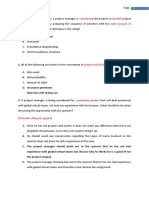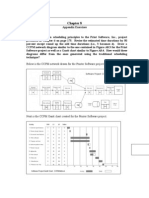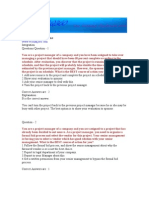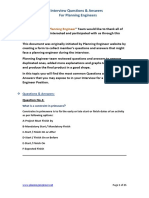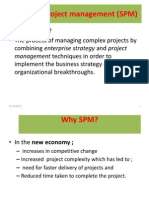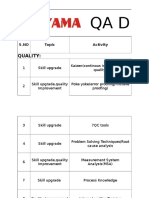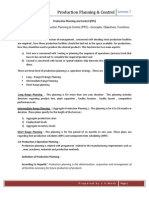Time Management Test1
Time Management Test1
Uploaded by
tkurasaCopyright:
Available Formats
Time Management Test1
Time Management Test1
Uploaded by
tkurasaOriginal Description:
Copyright
Available Formats
Share this document
Did you find this document useful?
Is this content inappropriate?
Copyright:
Available Formats
Time Management Test1
Time Management Test1
Uploaded by
tkurasaCopyright:
Available Formats
Project Time Management
Practice Exam
1. To control the schedule, a project manager is reanalyzing the project to predict
project duration. She does this by analyzing the sequence of activities with the least
amount of scheduling flexibility. What techniques is she using?
A. Critical path method
B. Flowchart
C. Precedence diagramming
D. Work breakdown structure
2. A dependency requiring that design be completed before manufacturing can start is
an example of a:
A. discretionary dependency
B. external dependency
C. mandatory dependency
D. scope dependency
3. Which of the following are GENERALLY illustrated BETTER by bar charts than
network diagrams?
A. Logical relationship
B. Critical paths
C. Resource trade-offs
D. Progress or status
4. If the optimistic estimate for an activity is 12days, and the pessimistic estimate is
18days, what is the standard deviation of this activity?
A. 1
B. 1.3
C. 6
D. 3
5. A heuristic is best described as a:
A. control tool
B. scheduling method
C. planning tool
D. rule of thumb
6. Lag means:
A. the amount of time an activity can be delayed without delaying the project
finish
date
Project Time Management
B. the amount of time an activity can be delayed without delaying the early start
date of its successor
C. waiting time
D. the product of a forward and backward pass
7. Which of the following is the BEST project management tool to use to determine
the longest time the project will take?
A. WBS
B. Network diagram
C. Bar chart
D. Project charter
8. Which of the following is CORRECT? A. A critical path can run over a dummy
B. There can be only one critical path
C. The network diagram will change every time the end date changes D.
A project can never have negative float
9. What is the duration of a milestone?
A. Shorter than the duration of the longest activity
B. Shorter then the activity it represents
C. There is no duration
D. Same length as the activity it represents
10. Which of the following BEST describes the relationship between standard deviation
and risk?
A. Nothing
B. Standard deviation tells you if the estimate is accurate
C. Standard deviation tells you how unsure the estimate is D. Standard deviation
tells you if the estimate includes a pad.
11. Monte Carlo analysis used to:
A. get an indication of the risk involved in the project
B. estimate an activitys length
C. simulate the order in which activities occur
D. prove to management that extra staff is needed
12. The float of an activity is determined by:
A. performing a Monte Carlo analysis
B. the waiting time between activities
C. determining log
D. determining the amount of time the activity can be delayed before it delays the
critical path
Project Time Management
13. A project has three critical paths. Which of the following BEST describes how this
affects the project?
A. It makes it easier to manage
B. It increases the project risk
C. It requires more people
D. It makes it more expensive
14. If project time and cost are not as important as the number of resources used each
month, which of the following is the BEST thing to do?
A. perform a Monte Carlo analysis
B. fast track the project
C. perform resource leveling
D. analyze the life cycle costs
15. When would a milestone chart be used instead of a bar char?
A. project planning
B. reporting to team members
C. reporting to managers
D. risk analysis
16. Your project management plan results in a project schedule that is too long. If the
project network diagram cannot change but you have extra personnel resources,
what is the BEST thing to do?
A. fast track the project
B. level the resources
C. crash the project
D. Monte Carlo analysis
17. The precedence diagramming method (activity-on-node) is different from the arrow
diagramming method (activity-on-arrow) because a precedence diagram: A. can use
PERT.
B. has four relationships among activities
C. has only finish-to-finish relationships
D. may use dummy activities
18. Which of the following is the BEST thing to do to try to complete a project two
days earlier?
A. Tell senior management that the projects critical path does not allow the
project to be finished earlier
B. Tell your boss
C. Meet with team and look for options for crashing or fast tracking the critical
path
D. Work hard and see what the project status is next month
Project Time Management
19. In attempting to complete the project faster, the project manager looks at the cost
associated with crashing each activity. The BEST approach to crashing would also
include looking at the:
A. risk impact of crashing each activity
B. customers opinion of which activities to crash
C. bosss opinion of which activities to crash and in which order
D. project life cycle phase in which the activity is due to occur
20. A project manager is trying to coordinate all the activities on the project and has
determined the following:
Activity 1 can start immediately and has an estimated duration of one week.
Activity 2 can start after activity 1 is completed and has an estimated duration of four
weeks. Activity 3 can start activity 2 is completed and has an estimated duration of five
weeks. Activity 4 can start after activity 1 is completed and has an estimated duration of
eights weeks. Both activities 3 and 4 must be completed before the end of the project.
What is the duration of the critical path for this project?
A.10
B. 11
C. 14
D. 8
21. Based on the data in the question above, if the activity 4 takes 10 weeks, what is the
duration of the critical path?
A.10
B.11
C.14
D.8
22. Which of the following includes asking team members about the time estimates for
their activities and reaching agreement on the calendar date for each activity?
A. Activity sequencing
B. Schedule development
C. Scope definition
D. Creating a project charter
23. A project manager is in the middle of the executing process of a very large
construction project when he discovers that the time needed to complete the project
is longer than the time available. What is the BEST thing to do?
A. Cut product scope
B. Meet with management and tell them that the required date cannot be met.
C. Work overtime
D. Determine options for schedule compression and present management with
your recommended option
4
Project Time Management
24. During project planning, you estimate the time needed for each activity and then
add the estimates to create the project estimate. You commit to completing the
project by this date. What is WRONG with this scenario?
A. The team did not create the estimate and estimating takes too long using that
method.
B. The team did not create the estimate and a network diagram was not used
C. The estimate is too long and should be created by management
D. The project estimate should be the same as the customers required
completion date.
25. During activity definition, a team member identifies an activity that needs to be
accomplished. However, another team member believes that the activity is not part
of the project as he interprets the project scope statement. What is the BEST thing
for the project manager to do?
A. try to build the consensus of the team
B. make the decision herself
C. ask the sponsor for clarification
D. ask senior management for clarification
26. You are a project manager on a U.S. $5,000,000 software development project.
While working with your project team to develop a network disgram, you notice a
series of activities that can be worked in parallel but must finish in a specific
sequence.
What type of activity sequencing method is required for these activities?
A. precedence diagramming method
B. arrow diagramming method
C. critical path method
D. operational diagramming method
27. You are a project manager on a U.S. $5,000,000 software development project.
While working with your project team to develop a network diagram, your data
architects suggest that quality could be improved if the data model is approved by
senior management before moving on to other design elements. They support this
suggestion with an article from a leading software development journal. Which of
the following BEST describes what this type of input is called?
A. mandatory dependency
B. discretionary dependency
C. external dependency
D. heuristic
28. Based on the following, if you need to shorten the duration of the project, what
activity would you try to shorten?
5
Project Time Management
Activity
Start-A
Start-B
Start-C
A-D
B-E
C-E
C-F
F-End
E-End
D-End
A.
B.
C.
D.
Estimate (in
Weeks)
1
2
6
10
1
Dummy
2
3
9
1
activity start-B
Activity A-D
Activity E-END
Activity C-E
29. You have a project with the following activities: Activity A takes 40 hours and can
start after the project starts. Activity B takes 25 hours and should happen after the
project Starts .Activity C must happen after activity A and takes 35 hours. Activity
D must happen after activity B and C and takes 30 hours. Activity E must take place
after activity C and takes 10 hours. Activity F takes place after Activity E and takes
22 hours. Activities F and D are the last activities of the project. Which of the
following is TRUE if activity B actually takes 37 hours?
A. the critical path is 67 hours
B. the critical path changes to Start , B, D, End
C. the critical path is Start,A,C,E,F,End
D. the critical path increases by 12 hours
30. A project manager has received activity duration estimates from his team. Which of
the following does he need in order to complete schedule development?
A. change requests
B. schedule change control system
C. recommended corrective actions
D. reserves
31. A project manager is taking over a project from another project manager during the
planning process group. If the new project manager wants to see what the previous
project manager planned for managing changes to the schedule, it would be BEST
to look at the:
A. communications management plan
6
Project Time Management
B. project management plan
C. staffing management plan
D. schedule management plan
32. A project manager is using weighted average duration estimates to perform
schedule network analysis. Which type of mathematical analysis is being used?
A. critical path method
B. PERT
C. Monte Carlo
D. resource leveling
33. The WBS, estimates for each work package, and the network diagram are
completed.
Which of the following would be the NEXT thing for the project manager to do?
A. sequence the activities
B. verify that they have the correct scope
C. create a preliminary schedule and get the teams approval
D. complete risk management
34. A new product development project has four levels in the work breakdown structure
and has been sequenced using the arrow diagramming method. The activity
duration estimates have been received. What should be done NEXT?
A. create an activity list
B. begin the work breakdown structure
C. finalize the schedule
D. compress the schedule
35. You are a project manager for a new product development project that has four
levels in the work breakdown structure, and has been sequenced using the arrow
diagramming method. The duration estimates have been compressed and a schedule
created. What time management activity should u do NEXT?
A. begin schedule control
B. begin activity resource estimating
C. analogously estimate the schedule
D. gain approval
36. A team member from research and development tells you that her work is too
creative to provide you with a fixed single estimate for the activity. You both decide
to use the labor hours from the past projects to predict the future. This is an example
of which of the following?
A. parametric estimating
B. three-point estimating
C. analogous estimating
D. Monte Carlo analysis
Project Time Management
37. An activity has an early start (ES) of day 3, a late start (LS) of day 13, an early
finish (EF) of day 9, and a late finish (LF) of day 19. The activity:
A. is on the critical path
B. has a lag
C. is progressing well
D. is not on the critical path
38. The project is calculated to be completed four days after the desired completion
date. You do not have access to additional resources. The project is low risk, the
benefit cost ratio (BCR) is expected to be 1.6, and the dependencies are preferential.
Under these circumstances what would be the best thing to do?
A. cut resources from an activity
B. make more activities concurrent
C. move resources from the preferential dependencies to the external
dependencies
D. remove an activity from the project
39. A project manager for a small constructions company has a project that was
budgeted for U.S.$130,000 over a six week period. According to her schedule, the
project should have cost U.S.$60,000 to date. However, it has cost U.S.$90,000 to
date. The project is also behind schedule, because the original estimates were not
accurate. Who has the PRIMARY responsibility to solve this problem?
A. project manager
B. senior management
C. project sponsor
D. manager of the project management office
40. Your organization is having a difficult time managing all of its projects. You have
been asked to help senior management understand this. Which of the following
types of reports would help provide summary information to senior management?
A. detailed cost estimates
B. project management plans
C. bar charts
D. milestone reports
41. Rearranging resources so that a constant number of resources is used each month is
called:
A. crashing
B. floating
C. leveling
8
Project Time Management
D. fast tracking
42. Which of the following is a benefit of an analogous project estimate?
A. estimate will be closer to what the work will actually require
B. it is based on a detailed understanding of what the work requires C it
gives the project team an understanding of managements expectations
D. it helps the project manager determine if the project will meet the schedule
43. During project executing, a large number of changes are made to the project. The
project manager should:
A. wait until all changes are known and print out a new schedule
B. make approved changes as needed, but retain the schedule baseline
C. make only the changes approved by management
D. talk to management before any changes are made
Time Management Answers
1. Answer A
Explanation There are only two choices related to scheduling: A and C. Choice C,
however is diagramming technique that deals with the relationship between activities, not
schedule flexibility.
2. Answer C.
Explanation Since the dependency is required it could not be discretionary (choice
A) and therefore must be mandatory. No mention is made that the dependency comes
from a source outside the project, so external (choice B) is not correct. Scope dependency
(choice D) is not a defined term. The key word in this question is requires. The
question defines the mandatory dependency.
3. Answer D
Project Time Management
Explanation The bar chart (or Grant chart) is designed to show a relationship of
activities to time. This is best used when demonstrating progress or status as a factor of
time.
4. Answer A
Explanation The standard deviation is computed by (p-o)/6. Therefore, the answer is
(18-12)/6 = 6/6 = 1.
5. Answer D
Explanation A heuristic is a rule of thumb. Examples are cost per line of code, cost
per square foot of floor space, etc
6. Answer C
Explanation Total float and free float (choices A and B) are the time an activity can be
delayed without impacting the entire project or the next activity. CPM (Choice D) is a
schedule network analysis technique, not waiting time. Choice C is the correct answer.
7. Answer B
Explanation The bar chart (choice C) may show an end date, but it is not used to
determine dates and show progress. The project charter (choice D) may include any
required end dates, but not a logical determination of how long the project will take. The
network diagram (choice B) takes the work packages from the work breakdown structure
(choice A) and adds dependencies. The dependencies allow us to look at the various paths
through the diagram. The longest duration path is the critical path. Choice B is the best
answer.
8. Answer A
Explanation This question tests your knowledge about a number of topics. There can
often be more than one critical path (choice B) but you might adjust to decrease risk
resulting in only one critical path. Choice C uses the word will. The network diagram
may change or it may not, depending on the amount of schedule reserve and the reason
for the change to the schedule. You can have negative float (choice D) if yoy are behind
schedule. Only choice A is correct.
9. Answer C
Explanation A milestone shows the completion of a series of activities or work
packages. Therefore it takes no time of its own. With this in mind choice C is the best
answer.
10. Answer C
Explanation Choice A is not best, as the standard deviation tells you the amount of
uncertainty or risk involved in the estimate for the activity. An estimate can have a wide
range (choice B) and still be accurate if the item estimated includes risks. Choice D
cannot be the best answer since there is no such thing as a pad in project management. An
estimate might be inflated, but it is because o risks, not padding.
10
Project Time Management
11. Answer A
Explanation Notice how many choices are half right? Monte Carlo could help you
know that an estimate for an activity needs to change, but not what the activity estimate
should be (choice B). Monte Carlo is a simulation (choice C) but it simulates time, not
order of activities. Monte Carlo can be used to prove things to management (choice D)
but its main focus deals with time, not staff. Risk can be assessed using Monte Carlo
analysis (choice A). By considering the inputs to the PERT estimates and the network
diagram, you can obtain a better overview of the overall project risk.
12. Answer D
Explanation This question does not specify what type of float. Total float is the
amount of time an activity can be delayed without impacting the end date of the project.
Free float is the amount of time an activity can be delayed without impacting the early
start of the next activity. The only choice matching either of these definitions is choice D.
13. Answer B
Explanation Though having three critical paths COULD require more people
(choice C) or cost more (choice D) the answer that is definitely and always true, is B.
Because you need to manage three critical paths, there is more risk that something could
happen to delay the project.
14. Answer C
Explanation fast tracking (choice B) would affect time and cost. Monte Carlo
analysis and life cycle costs (choice A and D) do not directly deal with resources.
Leveling (choice C) is the only one that will definitely affect resources.
15. Answer C
Explanation Project planning (choice A) would use both types of charts. Team
members (choice B) need to see details and so they need a bar chart rather than a
milestone chart. Risk analysis (choice D) COULD make use of both charts. A milestone
chart is used instead of a bar chart for any situation where you want to report in a less
detailed way (choice C). Bar charts can scare people with their complexity and often
show too much detail to be worthwhile on a management level. Milestone charts are
more effective for reporting to management.
16. Answer C
Explanation leveling resources (choice B) generally extends the schedule. Monte
Carlo analysis (choice D) does not directly address the constraints of this situation. To
compress the schedule, you could either crash or fast track. However, the situation says
that the network diagram cannot change. This eliminates the fast tracking option (choice
A), leaving choice C as the best answer.
17. Answer C
11
Project Time Management
Explanation Choices A, C, and D apply only to activity on arrow diagrams. B is the
only correct answer.
18. Answer C
Explanation This is another question that asks about problem solving. Only choice
C relates to evaluate. Choices B and D do not try to solve the real problem. Choice A is
just an untrue statement.
19. Answer A
Explanation You may or may not need your customers (choice B) or your bosss
(choice c) input but you will definitely need to include an analysis of risk. Choice A is
broader than choice D and therefore is better.
20. Answer A
Explanation You need to draw a network diagram for this question.
Figure
This diagram has two paths: Start, 1, 2, 3 End and Start, 1, 4, End. The length of the first
path is 10 and the second is nine making the first path critical and the duration of the
critical path 10. Notice that almost every other answer someone could pick is also listed.
21. Answer B
Explanation If activity 4 now takes 10 weeks instead of eight, the critical path
would change to Start, 1, 4 End and be 11 weeks long.
12
Project Time Management
22. Answer B
Explanation By the time this activity is taking place, activity sequencing (choice
A) scope definition (choice C) and creating a project charter (choice D) would be
completed.
23. Answer D
Explanation this question tests whether you know how to solve problems, especially
if you are one of those project managers who has not realized that an unrealistic schedule
is something you should deal with before beginning work. Since cutting product scope
affects the customer, choice A has a great negative effect and is therefore not best. A
project managers job is to determine options for meeting any end date or time. Therefore
choice B cannot be correct. Working overtime (choice C) is expensive and unnecessary
when there are so many other choices that could be selected first. Choice D could have
the least negative impact on the project.
24. Answer B
Explanation Time estimates for the activities should be created by the team and
should not be added. Some activities may take place concurrently. Therefore, Choice B
must be the correct answer.
25. Answer C
Explanation The project scope statement is created based on the preliminary project
scope statement and input from the sponsor. Therefore the answer is choice C, ask the
sponsor.
26. Answer A
Explanation The question implies a finish-to-finish relationship between activities.
The arrow diagramming method (choice B) does not support these types of relationships.
Choice C is not a diagramming method and choice D is a made-up term.
27. Answer B.
Explanation the situation is neither mandatory (choice A) nor driven by an external
source (choice C). A rule of thumb (choice D) is something that can be used consistently.
This situation is a unique occurrence. The situation is a suggestion or a preferred
method, so choice B is the best answer.
28. Answer C
Explanation This is one of the two-stage question you will find on the exam. First
you need to draw the network diagram and find the critical path, then make a decision.
The network diagram would be:
Figure
13
Project Time Management
The diagram above has four paths:
Table
The critical path is 15(Start-C, C-E, E-End) and runs across the dummy (yes that can
happen). Without any other information to suggest another alternative, it is best to try to
shorten the longest activity on the critical path, activity E-End (choice C).
You may have selected activity A-D (choice B) because it is the longest activity, but
notice that shortening it will not change the length of the project. You may not have
understood a dummy and tried to look for the longest path that does not includes a
dummy. If you did, you would have found that Start-B,B-E,E-End and Start-A,A-D,DEnd
are the same length.
29. Answer C
Explanation Did you notice how difficult this question was to read? Such wording is
intentional, to prepare you for interpreting questions on the real exam. Looking at this
situation, you see that there are three paths through the network. They are Star,A,C,E,F
End with a duration of 40 + 35 + 10 + 22 or 107,Start,A,C,D,End with a duration of
40+35+30 or 105, and Start,B,D,End with a duration of 25+30 or 55. If the duration of
the activity B changes from 25 to 37, the activity will 12 hours longer. As the activity is
only on the third path, it will only change the duration of that path from 55 to 55 + 12 or
67 hours. Since the duration of the critical path is 107 hours, the delay with activity B
will have no impact on the project timeline or the current critical path.
14
Project Time Management
30. Answer D
Explanation Schedule development includes all work and uses all inputs needed to
come up with a finalized, realistic schedule. One would need time reserves (choice D) in
order to complete a schedule. All of the other items are parts of schedule control and
occur after schedule development.
31. Answer D
Explanation Answer D is the most correct answer. The schedule management plan
is an output of schedule development and is the repository for plans for schedule changes.
32. Answer B
Explanation PERT uses a weighted average.
33. Answer D
Explanation Choice A is the same thing as create a network diagram. Choice B is
another name for scope verification, and is done during the monitoring and controlling
process group, not during project planning. Since a schedule is an input to risk
management, choice D comes after choice C and so it is not the next thing to do. The
only remaining choice is C.
34. Answer D
Explanation The question is really asking, What is done after activity duration
estimation? Choices A and B are done before activity duration estimating. Duration
compression (choice D) occurs before finalizing the schedule (choice C) and is, therefore,
the best answer.
35. Answer D
Explanation Notice how this question and the one previous seem very similar. This is
intended to prepare you for similar questions on the exam. Choices B and C should have
already been completed. The situation described is within the schedule development
process of time management Choice A is the next time process after schedule
development, but schedule development is not finished. Final approval (choice D) of then
schedule by the stakeholders is needed before one has a project schedule.
36. Answer A
Explanation Past history is being used to calculate an estimate.Monte Carlo (choice
D) relates to what-if analysis. Choice B uses three time estimates per activity. One could
use past history to come up with the estimate (choice C) but the best answer is choice A
because an estimate such as hours per installation is a chief characteristic of parametric
estimates.
37. Answer D
15
Project Time Management
Explanation The activity described has float because there is a difference between
the early start and late start. An activity that has float is probably not on the critical path.
There is no information presented about lag (choice B) or progress (choice C) so choice
D is the best answer.
38. Answer B
Explanation Cutting resources from an activity (choice A) would not save time, nor
would moving resources in the way described (choice C). Removing an activity from the
project (choice D) is a possibility, but since the dependencies are preferential and the risk
is low, the best choice would be to make more activities concurrent (choice B) as this
would have less impact on the project.
39. Answer A
Explanation Did u get lost looking at the numbers presented in this question? Notice
that there are no calculations required, simply an understanding of what the problem is.
Many project managers try to solve problems that are not within their area of control.
This question describes schedule management, which is a responsibility of the project
manager. This question relates to cost, integration, human resources and time.
40. Answer D
Explanation Detailed estimates (choice A) have nothing to do with the situation
described. Project management plan (choice B) will have more detail that is necessary
for the situation described and may distract from the conversation if used in this situation.
Bar charts (choice C) are usually only for the team. The best answer is choice D because
milestone reports present the right level of detail for upper management.
41. Answer C
Explanation The key to this question is the phrase constant number used each
month. Only leveling, choice C, has such an effect on the schedule.
42 Answer C
Explanation Remember that analogous estimates are top-down, high-level estimates.
Therefore, choices A and B cannot be correct. The project manager needs more than an
analogous estimate to determine if the project will meet the schedule (choice D). I t is a
benefit to know managements expectations of how much the project will cost so that any
differences between the analogous estimate and the detailed bottom-up estimate can be
reconciled in the planning processes. The best choice is C.
43 Answer B
Explanation A project manager must be more in control of the project than choices
C and D reflect. Choice A is a common error many project managers make. Instead, the
project manager should be controlling the project throughout the completion of the
project.
16
Project Time Management
17
You might also like
- CBP Questions PracticeDocument17 pagesCBP Questions PracticeDwain_25100% (8)
- The Bcs Professional Examinations BCS Level 5 Diploma in IT April 2008 Examiners' Report IT Project ManagementDocument12 pagesThe Bcs Professional Examinations BCS Level 5 Diploma in IT April 2008 Examiners' Report IT Project ManagementOzioma Ihekwoaba100% (1)
- GSCM-17-Global Manufacturing and Supply Chain ManagementDocument24 pagesGSCM-17-Global Manufacturing and Supply Chain Managementabdul rehmanNo ratings yet
- Time Management TestDocument16 pagesTime Management Testtkurasa100% (1)
- PMADocument226 pagesPMAHiệp Văn Tạ100% (1)
- Q & A Project Time ManagementDocument10 pagesQ & A Project Time ManagementmukhlisNo ratings yet
- PSP P-2Document15 pagesPSP P-2Deejaay2010100% (1)
- Project Shcedule ManagementDocument33 pagesProject Shcedule ManagementABDELMALEK .TEBOUDANo ratings yet
- Project Planning and ControlDocument11 pagesProject Planning and ControlPKyromitis0% (1)
- The Bcs Professional Examinations BCS Level 5 Diploma in IT October 2009 Examiners' Report IT Project Management Section ADocument10 pagesThe Bcs Professional Examinations BCS Level 5 Diploma in IT October 2009 Examiners' Report IT Project Management Section AOzioma IhekwoabaNo ratings yet
- 4 3answersDocument39 pages4 3answersjagcha64100% (1)
- Microsoft Project 2007 Exercise TutorialDocument10 pagesMicrosoft Project 2007 Exercise TutorialDebashish NandanNo ratings yet
- Chap 005Document11 pagesChap 005Cynthia89% (19)
- Poject Mangement Process Question - Section 1 - Project Management QuestionDocument7 pagesPoject Mangement Process Question - Section 1 - Project Management QuestionHuda AlShammari100% (1)
- Planning Scheduling Using PrimaveraDocument10 pagesPlanning Scheduling Using PrimaveraMohammedNo ratings yet
- Questions On Network ProblemsDocument2 pagesQuestions On Network ProblemsKenneth RonoNo ratings yet
- Ass 2Document2 pagesAss 2Ankush Jakhmola67% (3)
- Extra Exercises On Network Diagrams, 6thed 20090518Document7 pagesExtra Exercises On Network Diagrams, 6thed 20090518Joaquin Casanova PerozoNo ratings yet
- HW9 KeyDocument13 pagesHW9 Keycsagiroglu11100% (1)
- 70-178 Answerss Last Version10Document19 pages70-178 Answerss Last Version10tres567100% (1)
- PMP Critical Path Method Exercises PDFDocument8 pagesPMP Critical Path Method Exercises PDFLovely CardanoNo ratings yet
- PMP Exam-Paper SabarniDocument38 pagesPMP Exam-Paper Sabarnilitu100% (1)
- PSP P-5Document13 pagesPSP P-5sohambandyopadhyay1677No ratings yet
- Exercises in PERTCPMDocument4 pagesExercises in PERTCPMvamsy5690% (2)
- Chapter 6 - Project CrashingDocument45 pagesChapter 6 - Project Crashingpriyaa03No ratings yet
- Bench Mark 2 NameDocument29 pagesBench Mark 2 NameShoaib Khot100% (1)
- PMP QuestionsDocument27 pagesPMP Questionsteststudydocs100% (3)
- Planning SkillDocument63 pagesPlanning SkillDeejaay201050% (2)
- 3 Project Management Project CrashingDocument4 pages3 Project Management Project CrashingfireflyzzzNo ratings yet
- Interview Questions & Answers For Planning Engineers: AcknowledgmentDocument27 pagesInterview Questions & Answers For Planning Engineers: AcknowledgmentBoinboin HadratNo ratings yet
- Critical PathDocument6 pagesCritical Pathmashud sardarNo ratings yet
- Project - Network Analysis (PERT and CPM) L1Document39 pagesProject - Network Analysis (PERT and CPM) L1Arnab GhoshNo ratings yet
- Project Management BookDocument224 pagesProject Management BookBramNo ratings yet
- 07-Project Resources ManagementDocument29 pages07-Project Resources Managementmohamed gakoshNo ratings yet
- Primavera QuestionDocument12 pagesPrimavera QuestionteccNo ratings yet
- Braindump JK0-017Document87 pagesBraindump JK0-017cremer.rikeNo ratings yet
- PMP Exams Sample QuestionsDocument6 pagesPMP Exams Sample QuestionsAdura OgunnuNo ratings yet
- Week 5 - Strategic Project ManagementDocument13 pagesWeek 5 - Strategic Project Managementdmugalloy100% (1)
- 05-Project Cost ManagementDocument27 pages05-Project Cost Managementmohamed gakoshNo ratings yet
- Control Accounts, Work Packages, Planning PackagesDocument11 pagesControl Accounts, Work Packages, Planning PackageskbaltimoreNo ratings yet
- Pmbok 2Document11 pagesPmbok 2Deepak RathiNo ratings yet
- Scope AnswersDocument65 pagesScope Answerssatish kumarNo ratings yet
- Exam PM 2Document24 pagesExam PM 2Mary Angel HerdezNo ratings yet
- Question Two (MS Project - 30 Marks) : Task No Task Duration Predecessor Resources 1 Project ScopeDocument2 pagesQuestion Two (MS Project - 30 Marks) : Task No Task Duration Predecessor Resources 1 Project ScopeReagan SsebbaaleNo ratings yet
- Crashing in Project ManagementDocument8 pagesCrashing in Project ManagementanayochukwuNo ratings yet
- Steps in Construction SchedulingDocument6 pagesSteps in Construction SchedulingBandar AlshammariNo ratings yet
- 6 - Week 5-Case Study-Project Integration ManagementDocument2 pages6 - Week 5-Case Study-Project Integration Managementranaumair1326No ratings yet
- Planning & SchedulingDocument16 pagesPlanning & SchedulingManav Anil JainNo ratings yet
- Critical Path MethodDocument54 pagesCritical Path MethodKenneth Bryan Copino100% (1)
- p6 Interview QuestionsDocument2 pagesp6 Interview Questionsvinaysiri99No ratings yet
- CIDM 6390 Project Management Final ExamDocument7 pagesCIDM 6390 Project Management Final Examconrongcodon100% (1)
- Project ManagementDocument28 pagesProject ManagementRohan ChhajedNo ratings yet
- Hussein Edrees PMP Notes PDFDocument72 pagesHussein Edrees PMP Notes PDFtechmail04100% (2)
- CPM critical path method or critical path management Complete Self-Assessment GuideFrom EverandCPM critical path method or critical path management Complete Self-Assessment GuideRating: 1 out of 5 stars1/5 (1)
- The PMP® Exam - Master and Leverage the ITTOsFrom EverandThe PMP® Exam - Master and Leverage the ITTOsRating: 1 out of 5 stars1/5 (2)
- SumitomoType 71cDocument2 pagesSumitomoType 71ctkurasaNo ratings yet
- SPRC BasicsDocument50 pagesSPRC BasicstkurasaNo ratings yet
- GH How To Handle Issue Management in A PMO SettingDocument5 pagesGH How To Handle Issue Management in A PMO SettingtkurasaNo ratings yet
- James 1 19 27 QuesDocument2 pagesJames 1 19 27 QuestkurasaNo ratings yet
- ProcurementDocument35 pagesProcurementtkurasaNo ratings yet
- PMP Time ExamDocument6 pagesPMP Time ExamtkurasaNo ratings yet
- Using The Balanced Scorecard As A Strategic Management SystemDocument7 pagesUsing The Balanced Scorecard As A Strategic Management SystemtkurasaNo ratings yet
- Five Steps To Effective ProcurementDocument7 pagesFive Steps To Effective ProcurementtkurasaNo ratings yet
- Project Scheduling and Resource LevellingDocument3 pagesProject Scheduling and Resource LevellingtkurasaNo ratings yet
- Sample Risk MatrixDocument4 pagesSample Risk MatrixtkurasaNo ratings yet
- Third John: Gene TaylorDocument6 pagesThird John: Gene TaylortkurasaNo ratings yet
- Checklist For Event PlanningDocument1 pageChecklist For Event PlanningtkurasaNo ratings yet
- First Thessalonians: Gene TaylorDocument10 pagesFirst Thessalonians: Gene TaylortkurasaNo ratings yet
- Commands 12Document4 pagesCommands 12tkurasaNo ratings yet
- Second Timothy: Gene TaylorDocument8 pagesSecond Timothy: Gene TaylortkurasaNo ratings yet
- Mintzberg 5pDocument5 pagesMintzberg 5ptkurasa100% (1)
- 2007 IGCSE Biology Written Paper Question PaperDocument24 pages2007 IGCSE Biology Written Paper Question Paperseyka4No ratings yet
- Exam Receipt SampleDocument1 pageExam Receipt SampletkurasaNo ratings yet
- Practice QuestionsDocument3 pagesPractice QuestionsOsama bin adnanNo ratings yet
- Data Envelopment Analysis (DEA) For Services Productivity ImprovementDocument18 pagesData Envelopment Analysis (DEA) For Services Productivity ImprovementSARANSH NAUGRAIYANo ratings yet
- 20: Theory of CostDocument44 pages20: Theory of CostKeahlyn Boticario CapinaNo ratings yet
- Christian N. Madu PH.D (Auth.) - Handbook of Total Quality Management-Springer US (1998) PDFDocument829 pagesChristian N. Madu PH.D (Auth.) - Handbook of Total Quality Management-Springer US (1998) PDFAL KURNIA SANDINo ratings yet
- VP Operations Medical Devices in Boston MA Resume Erik BatesDocument4 pagesVP Operations Medical Devices in Boston MA Resume Erik BatesErikBatesNo ratings yet
- TpsDocument47 pagesTpsMohammad Ibnu SabilillahNo ratings yet
- Mathematical Modeling in EconomoicsDocument11 pagesMathematical Modeling in EconomoicsRaihan MahmudNo ratings yet
- Lecture 5-Optimization and Short Term Decisin Making-1Document23 pagesLecture 5-Optimization and Short Term Decisin Making-1ttongoona3No ratings yet
- 16) Internal Quality AuditDocument11 pages16) Internal Quality AuditSagar DaundNo ratings yet
- Handbook For SAP PP in S4HANA Product... (Z-Library)Document477 pagesHandbook For SAP PP in S4HANA Product... (Z-Library)houssem.kalel100% (3)
- DeLucy White Paper QMSDocument4 pagesDeLucy White Paper QMSDanielleNo ratings yet
- Posc : Mill Test Cedificate Sertifikat Pengujian PabrikDocument5 pagesPosc : Mill Test Cedificate Sertifikat Pengujian PabrikSolikhul HarisNo ratings yet
- Cost Accounting Quiz 4Document4 pagesCost Accounting Quiz 4andreamrieNo ratings yet
- Quality Department Annual PlanDocument24 pagesQuality Department Annual PlanKumaravelNo ratings yet
- IE362 Group Technology and Flexible Manufacturing SystemDocument2 pagesIE362 Group Technology and Flexible Manufacturing SystemloshidhNo ratings yet
- 1-2 Cost Terms & PurposesDocument35 pages1-2 Cost Terms & PurposesCheng ChengNo ratings yet
- What Are The Common Problems With PCB and PCBADocument14 pagesWhat Are The Common Problems With PCB and PCBAjackNo ratings yet
- Lean Sustainability - Elizabeth A CudneyDocument332 pagesLean Sustainability - Elizabeth A CudneyMary Jecyle LudaNo ratings yet
- Unit - Ii: The Production Function Expresses A Functional Relationship Between Physical Inputs andDocument20 pagesUnit - Ii: The Production Function Expresses A Functional Relationship Between Physical Inputs andJunvy AbordoNo ratings yet
- APICS - Spare Parts AvailabilityDocument31 pagesAPICS - Spare Parts AvailabilityMurat AnlıNo ratings yet
- Iso 9000 QMDocument16 pagesIso 9000 QMVipin PachouriNo ratings yet
- VISI Machining-2016-LOW PDFDocument8 pagesVISI Machining-2016-LOW PDFBenedict JoNo ratings yet
- Production Planning & Control: Syllabus ContentsDocument10 pagesProduction Planning & Control: Syllabus ContentsShivani SharmaNo ratings yet
- Wal Mart: Supply Chain Management: K.Varun 123511Document20 pagesWal Mart: Supply Chain Management: K.Varun 123511Vũ Trang M-tpNo ratings yet
- Maintenance EngineeringDocument4 pagesMaintenance EngineeringDharshan Kofi0% (1)
- Tps KP Ws5 Group BoardDocument19 pagesTps KP Ws5 Group BoardAW19No ratings yet
- Lean RetailDocument16 pagesLean RetailKumar RahulNo ratings yet
- Managerial Accounting Absorption and Variable Costing 081712Document14 pagesManagerial Accounting Absorption and Variable Costing 081712Mary Ann Jacolbe BaguioNo ratings yet
- Problem 2 JitDocument2 pagesProblem 2 JitChristian J. AbbatuanNo ratings yet




